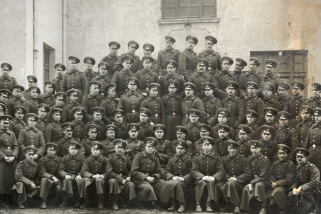Il sito della rivista è https://czasopisma.marszalek.
The ethnic landscape in the Baltic States is dominated by one large ethnic minority: Russians. Lithuania is an exception as here the first biggest ethnic minority are Poles, followed by Russians. The Baltic States have also significant Slavic minorities, such as Belarusians and Ukrainians. There are many barriers for people from different ethnic groups to overcome because the Baltic societies are segregated according to ethnicity across a number of dimensions: language, work and geography. During the Soviet period there were separate language schools, a system that reinforced ethnic separation. Labor market was also split along ethnic lines and a large proportion of ethnic minorities lived spatially segregated from the majority group and was concentrated mostly in urban centers. The impact of communist heritage and the construction of the post-communist state order had a negative impact on the integration process of the Russian minorities in those countries. The ethnic Russians had been heavily marginalized as many of them had no citizenship at all. As a result, they had limited access to labor-market and less social protection. However, the accession of the Baltic States to the European Union (EU) has succeeded in significantly changing policies with respect for and protection of minorities in the three Baltic countries. In the last years the ethnic Russians have in fact been partially accommodated through the consistency of the citizenship laws with the European Union norms, which precisely require the protection of minorities and respect for them. The aim of the study described herein is to investigate the historic roots of ethnic segregation between the native Baltic population and the Russian minority and show how the entry of the Baltic States into the EU has facilitated the process of promoting minority rights, especially from the perspective of granting citizenship right to Russian (and Polish) ethnic persons living in those countries.
REFERENCES:
- Ader, L.A. (May 2014). “Comparative Policy Analysis of Minority Language & Citizenship Ties: The cases of Ukraine, Latvia and Estonia”. Research Gate. Retrieved from: https://www.researchgate.net/
- Aptekar, S. (2009). “Contexts of Exit in the Migration of Russian Speakers from the Baltic Countries to Ireland”. Ethnicities, 9(4), pp. 507-526. DOI: https://journals.sagepub.com/doi/10.1177/1468796809345433.
- Brubaker, R. (1996). Nationalism Reframed: Nationhood and the National Question in the New Europe. Cambridge: Cambridge University Press. Commonwealth of the Independent States-Elections Monitoring Organization (CIS-EMO). (2017, September 15). “The issues of discrimination of non-citizens in the Baltic states”, OSCE. Retrieved from: https://www.osce.org/.
- Croft, J. (2016). “Non-Citizens in Estonia and Latvia: Time for Change in Changing Times?”. OSCE Yearbook 2015, Baden-Baden: IFSH, pp. 181-195.
- Di Gregorio, A. (2012). Epurazioni e protezione della democrazia: Esperienze e modelli di “giustizia post-autoritaria”, Milano: Franco Angeli.
- Di Gregorio, A. (2018, May 16). “Democratic Transition and Linguistic Minorities in Estonia and Latvia”. European Parliament. Retrieved from: http://www.europarl.europa.eu/.
- Druviete, I. (2002, April 16-20). “Language policy and protection of the state language in Latvia”. World Congress on Language Policies. Available at: http://www.linguapax.org/wp-content/uploads/2015/09/CMPL2002_T3_Druviete.pdf.
- Dumbrava, C. (2017/02). “Comparative Report: Citizenship in Central and Eastern Europe”. European University Institute-CADMUS. Retrieved from: http://cadmus.eui.eu/.
- Jano, D. (2008). “From ‘Balkanization’ to ‘Europeanization’: The Stages of Western Balkans Complex Transformations”, L’Europe en Formation, 3-4 (n° 349-350), pp. 11-12.
- Krepaz, K. (2016). The Impact of Europeanization on Minority Communities, Wiesbaden: Springer VS. Latvia vs. Estonia. Demographics (July 2017). indexmundi. Retrieved from: https://www.indexmundi.com/.
- Legal Information Centre for Human Rights, European Network on Statelessness and Institute on Statelessness and Inclusion (2015), “Joint Submission to the Human Rights Council at the24th Session of the Universal Periodic Review. Estonia”. European Network on Statelessness. Retrieved from: https://www.statelessness.eu/.
- Lietuvos Respublikos SEIMAS. (2010, November 4). “The Seimas has adopted amendments to the Law on Citizenship expanding possibilities of acquiring dual citizenship”. LRS. Retrieved from: http://www.lrs.lt/.
- Lietuvos žydų bendruomene. (2016, August 1). “Lithuanian Parliament Passes Amendment to Ensure Citizenship for Litvaks”, LŽB. Retrieved from: https://www.lzb.lt/en/.
- Ligenzowska, J., Piecuch, J. (2015). “National Minorities Integration in the Baltic States”. Studia Ekonomiczne, (228), p. 167-175. Identifier: http://polona.pl/item/50972398.
- Martini, G. (1999). “Stato, federalismo e minoranze” (State, Federalism and Minorities), Letterature di Frontiera = Littératures Frontalières, IX, 2, pp. 39-48.
- Ministry of Foreign Affairs of the Republic of Latvia. (2015, January 14). “Citizenship and Language Policy in Latvia”. MFA of Latvia. Retrieved from: http://www.mfa.gov.lv/en/.
- Ministry of Foreign Affairs of the Republic of Latvia. (2015, November 21). “Basic facts about citizenship and language policy of Latvia and some sensitive history-related issues”. MFA of Latvia. Retrieved from: http://www.mfa.gov.lv/en/.
- Ministry of Foreign Affairs of The Republic of Latvia. (2018, January 26). “Facts regarding society integration in Latvia”. MFA of Latvia. Retrieved from: http://www.mfa.gov.lv/en/.
- Ministry of Foreign Affairs of the Republic of Latvia. (2018, July 27). “Naturalization”. MFA of Latvia. Retrieved from: https://www.mfa.gov.lv/en.
- Ņujorkas latviešu ev. lut. Draudze. (2013, October 9). “Latvian parliament allows dual citizenship as of Oct. 1, 2013”. N.Y. Latvian Ev. Lut. Congregation. Retrieved from: http://www.nydraudze.org/.
- OSCE (2018). The Hague Recommendations regarding the Education Rights of National Minorities & Explanatory Note, Netherlands: OSCE High Commissioner on National Minorities.
- Payerhin, M. (2017). The World Today Series 2017-2018: Nordic, Central, and Southeastern Europe 2016-2017, Lanham: Rowman & Littlefield Publishers.
- Pilsonības un migrācijas lietu pārvalde. (2016, January 1). “Latvijas iedzīvotāju sadalījums pēc valstiskās piederības (Datums=01.01.2016)”. PMLP. Retrieved from: http://www.pmlp.gov.lv/.
- Popovski, V. (2000). National Minorities and Citizenship Rights in Lithuania, 1988-93, New York: Palgrave Macmillan UK. Press and Information Department, Ministry of Foreign Affairs. European Commission (2007, August). “Estonia Today: Citizenship”. MFA of Estonia. Retrieved from: http://vm.ee/en.
- Republic of Estonia, Ministry of Interior. (2017, April 15). “Citizenship and Migration”. MI of Estonia. Retrieved from: https://www.siseministeerium.ee/.
- Republic of Estonia, Ministry of Interior. (2018, October 9). “Citizenship and Migration”. MI of Estonia. Retrieved from: https://www.siseministeerium.ee/.
- Ruškytė, R. (2015, January). “UPDATE: Recent changes in citizenship law and policy. May 2010-January 2015. Lithuania”. GlobalCit, pp. 1-12. Retrieved from: http://globalcit.eu/.
- Rybakosvskij, L.L., Tarasova, N.V. (1990). “Migracionnye process v SSSR: Novye javlenija”. Sociologičeskie issledovanija, (7), pp. 32-42. Available at: http://ecsocman.hse.ru/data/602/990/1219/4-Rybakovskij.pdf.
- Stravinskienė, V. (2016). “Demografiniai pokyčiai Lietuvoje 1944-1989 m. (statistinis aspektas)”. Istorija. Lietuvos aukštųjų mokyklų mokslo darbai, 103 (3), pp. 27-50. DOI: http://dx.doi.org/10.15823/istorija.2016.09.
- Tesser L.M. (2005). “The Impact of the Post-Cold War European Minority Rights Regime on Inter-Ethnic Relations in Estonia and Latvia”. Archive of European Integration. Retrieved from: http://aei.pitt.edu/.
- TNS opinion & social (2018). Report of “Integration of immigrants in the European Union”. Special Eurobarometer survey 469. European Commission. Retrieved from: http://ec.europa.eu/.
- Törnquist-Plewa, B., Góra, M. (2015, January 21). “the EU as a normative success for national minorities. Before and after the EU enlargement”. Baltic Worlds. Retrieved from: http://balticworlds.com/.
- UNHCR. (1993, July 12). “Estonia: Aliens Act of 1993”. Refworld. Retrieved from: http://www.refworld.org/.
- Van Elsuwege, P. (2008). From Soviet republics to EU member states: A Legal and Political Assessment of the Baltic States’ Accession to the EU, Volume 1, Leiden: Martinus Nijhoff.
- van Ham M., Tammaru, T. (2011). “Ethnic Minority-Majority Unions in Estonia (Unions entre membres d’ethnies minoritaires et majoritaires en Estonie)”. European Journal of Population, 27 (3), pp. 313-335. DOI: http://dx.doi.org/10.1007/s10680-011-9236-z.
Author
cristina.carpinelli26@gmail.com, is an expert of CEECs. She is a Scientific Committee Member of CeSPI (International Problems Study Centre of Milan). She is also a member of the Italian Association for History Studies on Central and Eastern Europe (AISSECO-Department of International Studies, University of Rome). Last published works: L’Unione Europea e le minoranze etniche. Case-Studies: Ungheria, Romania e Paesi Baltici (co-author: Massimo Congiu), CreateSpace-an Amazon.com Company, May 18, 2016; L’Europa dell’Est e i nuovi nazional-populismi. I casi polacco e ungherese (Co-author: Massimo Congiu), Bonomo Editore, Ottobre 2017.













